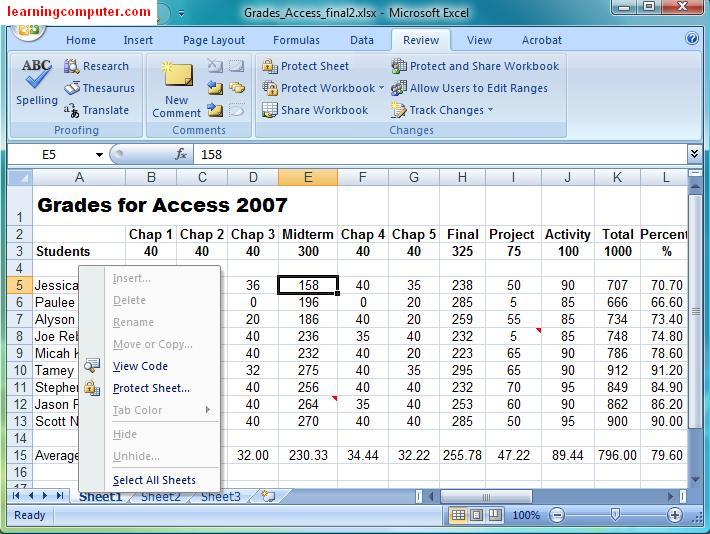In today's Microsoft Tutorial on Excel, we will cover Review Tab. This Tab has functionality that will let you proof read your Excel workbooks, add and delete comments, protect and unprotect Excel sheets/workbooks and finally allow users to track changes in a multi user Excel workbook.
The review Tab has the following Groups:
Proofing Group
Comments Group
Changes Group
For our practice today we are going to revisit the Grades Excel workbook that you have already seen in a prior lesson. Here is a screen shot of the Review Tab.
|
 |
Proofing Group :
The first Group that we will look at is Proofing. This has commands for checking spelling and grammar, using research and Thesaurus and ability to translate from one language to another. Let us take a look at some of these commands next. You are done working on your grade book and would like to check the spellings. You can click on spelling command which will invoke the spelling dialog box as shown below.
Notice that it found an incorrect spelling in cell L2. It also made some suggestions for the correct word which is Percent. Go ahead and click on Change to accept the suggestion. Remember you can also ignore ones that are correct or do not need to be changed. The Spell Checker will skip over such words and continue to check rest of your Excel sheet.
|
 |
Next we will look at the Research command which can be beneficial to look up information using online reference sources. For example I selected the word average in cell A15 and then clicked on Research on the Proofing Group on the Review Tab. This invoked the research dialog box on the right side as visible below. As you scroll down a little bit, you can see that it found not only the correct pronunciation but some common meanings for this work, very cool!
|
 |
The next feature is the one that I use a lot as I find myself repeating the same words over and over again. Using Thesaurus, Microsoft Excel 2007 will suggest words with similar meanings which can be used as alternates. On the computer screen capture below, you can see that it found the word Mean as an alternate to Average.
|
 |
The Translate command can be quite handy if you happen to work in a multilingual environment. Let us say that you would like to change the word average from English to Arabic. You can click on translate command which will bring up a new dialog box which I have expanded here so you can see the options a little bit better. Notice that not only did it suggests the word but was able to show the word in Arabic as well.
|
 |
Comments Group:
The next set of commands has to do with the Comments Group in Microsoft Excel 2007. if you happen to be working on a complex Excel project with several other people, it may be hard to track all the comments and changes from different sources. Using the comments functionality, Excel will let you add your notes and even include the user information.
|
 |
How about we try to add a few comments? For the student Joe Reboot, I feel the project points are way too low. So I went ahead and clicked on New Comment under Comments Group. This added a yellow comment box with my name and a blinking cursor around it. This is shown right below. A red triangle in the upper-right corner of the commented cell is also visible for easy location
|
 |
Similarly I added another comment in cell E12 at for Jason’s midterm score. I went ahead and saved the document. Let’s assume that someone else opens this Excel sheet and would like to review all the comments so for. They can easily click on the command Show All Comments. Excel displays all comment boxes on the current worksheet. Clicking the Show All Comments button again turns off the comment display.If the user has proper access, they can delete these comments and create their new ones.
|
 |
|
Changes Group:
Microsoft Excel 2007 has quite a bit of functionality in the security arena. This is a big improvement over the prior versions like Microsoft Excel 2003. There may be times when you would like to keep confidential information secure from modification and even control the structure of the workbook in Excel 2007.
Protect Sheet command will prevent users from accidental updating or deleting vital information from the spreadsheet. You can click on Protect Sheet under the Changes Group. This is going to bring up the time a dialog box titled the Protect Sheet. This is where you can enter a password along with several other options to limit actions in your worksheet. Go ahead enter a password and leave the default settings and then click OK. This is shown in the following figure.
|
 |
Next Excel 2007 will you will ask you to reenter the password to enable the security feature. Here’s the Confirm Password dialog box that I got on my computer screen. You can now close the worksheet.
|
 |
After protecting the sheet we need to test if this actually work. Open the Grades Workbook again and try to change data in Excel sheet. Notice you were unable to do so and you also received a dialog box similar to the one below informing you that this data is read only.
|
 |
If you wanted to make modifications, you would need to remove the protection using the Unprotect command under the Changes Group. Go ahead and click on Unprotect sheet command. This will invoke the dialog box where you are prompted to enter the password. Enter the password and then click OK. Now you are back to your original sheet where you can make modifications to the data. Awesome!
|
 |
In addition to protecting sheet you can also protect your workbook in Microsoft Excel. This prevents changes to the structure of the workbook and can also be utilized to control window functions like minimizing or closing worksheets. How about we try this functionality next?
When you click on protect workbook command, you will get a dropdown where you will select Protect Structure and Windows.
|
 |
Next You will get a similar dialog box to the one we have seen before. Go ahead and check the options for structure and windows, entered a password and then click OK.
|
 |
The changes from the previous step are quite subtle but you can see them if you look closely. The first thing that you will notice is missing window resizing buttons in the top right area and highlighted by the red rectangle. The second thing you’ll see is on the right click menu and, the commands for altering the worksheet properties are now disabled. We have included a screen shot of this right below.
|
 |
The last functionality that we will look at is protecting and sharing your workbook. This will let you protect your data using a password when working on a collaboration. In addition you can enable tracking changes using this command as. When you click on Protect and Share Workbook, you will get the following dialog box. This is where you can check the box for sharing the track changes by entering a password.
|
 |
|
Microsoft Excel 2007 invokes a new dialog box titled Highlight Changes. Here you can choose which options you would like to enable for tracking changes. I checked the boxes for When, Who and Where. You need to make sure that in the where clause text box, you highlight all of your tracked data. Finally click OK to complete the steps.
|
 |
TextNext proceed to make a few changes in your workbook. In our case, we made a comment about the midterm average being too low in cell E16. We also changed to score for Paulee Manson for chapter 4 and finally added another comment in the first row under column J. Go ahead and saved the document.
|
 |
Now if your colleague would like to know what changes were made?
They can simply opens this Excel Workbook, and then highlight changes using Track Changes command from the Changes Group. They will be prompted with the same when, who, where dialog box. They would need to check all the necessary boxes and then click OK. Next they will be able to see all the changes that need to be either accepted or rejected highlighted by a blue rectangle.
Here is a screen shot of what it looks like shown below.
|
 |
|

0 comments:
Post a Comment